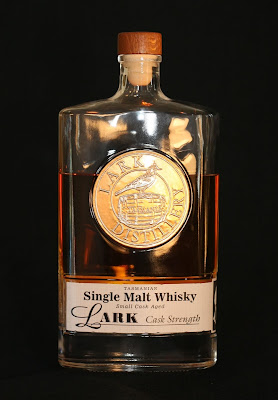 Last month I attended a pair of whisky tasting events organised by Todd Morrison of Destination Cellars, Hobart, Tasmania.
Last month I attended a pair of whisky tasting events organised by Todd Morrison of Destination Cellars, Hobart, Tasmania.
Standard versus Cask Strength Expressions
 The first event was held at T-42 on the Hobart waterfront and was hosted by Ivan Myers, Director of World of Whisky in Sydney. There were six whiskies on offer, two from Speyside distillery BenRiach, two from Tomatin in the Scottish Highlands and two from highly awarded Taiwanese distillery Karvalan. The theme of this tasting was to compare a standard diluted strength expression with a cask strength expression from the same distillery.
The first event was held at T-42 on the Hobart waterfront and was hosted by Ivan Myers, Director of World of Whisky in Sydney. There were six whiskies on offer, two from Speyside distillery BenRiach, two from Tomatin in the Scottish Highlands and two from highly awarded Taiwanese distillery Karvalan. The theme of this tasting was to compare a standard diluted strength expression with a cask strength expression from the same distillery.
BenRiach 10 Year Old (43% ABV) was the first whisky tasted. It smelt quite fruity with a faint scent of roasted nuts. There was a strong impression of crème caramel and some vanilla. The fruitiness continued when tasted, however, overall it tasted quite light. The finish was spicy on the tongue but not particularly lengthy.
The higher alcohol pairing was the BenRiach Cask Strength (57.2% ABV). This expression was noticeably spicier on the nose, with hints of cloves and dried fruit. The cask strength had an oilier mouthfeel to the 10 Year Old and was more spicy than fruity. The finish was spicy and long, concentrating at the back of the mouth, where the nasal passage connects to the throat.
The next two whiskies were from the Tomatin distillery. The Tomatin 12 Year Old (43% ABV) was first with a floral nose and strong sherry and fruitcake notes. It tasted light with hard to pinpoint flavours; butter menthol being the only one I could put my finger on. The finish was relatively short and peppery.
Next was the Tomatin Cask Strength (57.5% ABV). Considering the alcohol content, I was surprised just how inactive this whisky was on the nose. It was very hard to detect anything but a faint floral aroma and I wasn’t expecting much in the flavour department. Wow! I could not have been more wrong. I think I was too shocked by the spectacular flavour, to concentrate on exactly what I was tasting. Superb, and my favourite dram of the night. Highly recommended.
The last pair of whiskies were from Taiwanese distillery Kavalan. The Kavalan Ex-Bourbon Cask (46% ABV) was my first sample of anything from this unique and highly decorated distillery. Strong tropical fruit aromas of banana and melon. Very smooth to drink, with a short finish.
The cask strength offering was the Kavalan Solist Bourbon (58% ABV). The nose was of light tropical fruit with a spicy scent of clove. On tasting, it was spicy with vanilla and opened nicely with a little water. The finish was medium length and concentrated at the top of the mouth.
We were also very lucky to get to try the award winning ($700 a bottle) Kavalan Solist Amontillado Sherry Single Cask Strength, rated as the World’s Best Single Cask Malt Whisky in the 2016 World Whiskies Awards.
I would have preferred to have tried this earlier in the night rather than after all the previous whiskies, but nevertheless, I wasn’t going to look a gift horse in the mouth. The nose was quite light and with water opened to reveal tropical fruit and fizzy sherbet. I sampled too little to nail down all the flavours but I did notice spicy cinnamon followed by a long dry finish. A perfect way to cap off a great night of whisky tasting.
New World Whisky Distillery
The second whisky tasting evening was hosted by Todd Morrison at Destination Cellars and featured a selection of New World Whisky Distillery’s Starward Single Malts, experimental New World Projects expressions and gin. New World Whisky is an Australian distillery based in Melbourne. They recently relocated from a repurposed aircraft hanger in Essendon to a new site in Port Melbourne. New World Whisky pride themselves on making high-quality products at reasonable prices from only the best locally sourced barley and hand-picked exotic barrels such as ex-Australian Apera (sherry) and ex-wine barrels from South Australia.
There was something refreshingly different about the Starward Wine Cask Edition and I am proud to call it an excellent example of a truly Australian single malt whisky
First up was the Starward Wine Cask Edition Single Malt (41% ABV), recently named Best Australian Single Malt at the 2016 World Whiskies Awards. This whisky is matured exclusively in ex-Australian red wine barrels sourced from an undisclosed South Australian winery. The nose was sweet and fruity, delicate, with notes of strawberry. The sweetness continued on the palate with flavours of sweet summer berries followed by a medium-length finish that ended in a slightly bitter aftertaste. Although this was the first whisky tasted on the night, it turned out to also be my favourite. There was something refreshingly different about the Starward Wine Cask Edition and I am proud to call it an excellent example of a truly Australian single malt whisky.
 The flagship Starward Single Malt (43% ABV) was next, which is matured in ex-Australian Apera casks. Apera is the agreed name for a ‘sherry’, that does not originate from the Jurez region of Spain, much like how ‘Champagne’ is reserved for only sparkling white or rose wine that originates from the Champagne region of France. The nose was of strong tropical fruit, in particular, banana and melon. On tasting, it remained fruity on the palate and the ‘sherry’ or Apera influence was evident. There was also notes of spice rising above the fruit. The finish was medium length with fading spice.
The flagship Starward Single Malt (43% ABV) was next, which is matured in ex-Australian Apera casks. Apera is the agreed name for a ‘sherry’, that does not originate from the Jurez region of Spain, much like how ‘Champagne’ is reserved for only sparkling white or rose wine that originates from the Champagne region of France. The nose was of strong tropical fruit, in particular, banana and melon. On tasting, it remained fruity on the palate and the ‘sherry’ or Apera influence was evident. There was also notes of spice rising above the fruit. The finish was medium length with fading spice.
New World Projects are a range of experimental batches from New World Whisky and are generally either not available to the public or very limited releases. The NWP Project X 3 Year Old White Whisky (42% ABV) is a curious beast. It is as clear as water, but smells and tastes like a whisky. This alchemy has been achieved by charcoal filtering the aged whisky repeatedly until all the barrel tannins are removed. This leaves behind an aged spirit that looks like New Make (freshly distilled unaged spirit). This ‘White Whisky’ was created to challenge the whisky community and I think it achieves that goal. It certainly smells like whisky with a fruity nose and hints of sherry. It tasted very light with a thin mouthfeel, something I guess is to be expected after undergoing so much filtration. The finish was very short and abrupt with a slight spiciness. An interesting experiment indeed.
Next was the NWP Starward Limited Release PX Sherry Cask (48% ABV) which uses hand-selected imported Pedro Ximénez sherry casks. The nose was of cream, dried fruits, fruit cake and pineapple. It has a pleasant, oily mouthfeel (exaggerated perhaps by following the ‘White Whisky’) with sherry notes and fruit. The finish was medium length and spicy.
The last whisky for the night was the NWP First Distillery Last Release Cask Strength (62.3% ABV). The nose was surprisingly mild for a cask strength but opened slightly with water, releasing more detectable vapours. On tasting, there was an explosion of flavour with dried fruit and bitter dark chocolate bursting from a deliciously viscous oily mouthfeel, followed by a wave of spice that lingered for a long finish. Magnificent, but in very limited supply so keep an eye out for any future cask strength releases.
Gin
 The next two offerings were gin, which I am embarrassingly unfamiliar with – I am a WhiskyDad after all, not a GinDad.
The next two offerings were gin, which I am embarrassingly unfamiliar with – I am a WhiskyDad after all, not a GinDad.
First was Starward Barrel Aged Korenwijin Gin, which was intensely fragrant with strong juniper and medicinal notes. I struggled to pinpoint flavours but thought I detected something reminiscent of green vegetables. The finish was very short and abrupt and I found it too sweet for my tastes when mixed with tonic water.
The last item of the night was Starward Project 55 ‘Beer Garden Gin’. This gin is a collaboration between New World Whisky Distillery and 3 Ravens Brewery (I love their Smoke Beer). The Beer Garden Gin is made with 3 Ravens 55 American Pale Ale hops, juniper and Australian finger lime peel and released in very limited quantities (400 bottles). I found it to be pleasantly fragrant with strong flavours and a somewhat powdery finish. It was also quite nice with tonic water.
I would like to that both Ivan Myers and Todd Morrison for two very different and enjoyable evenings.






















